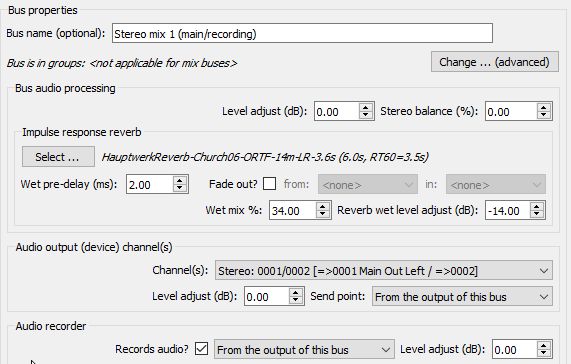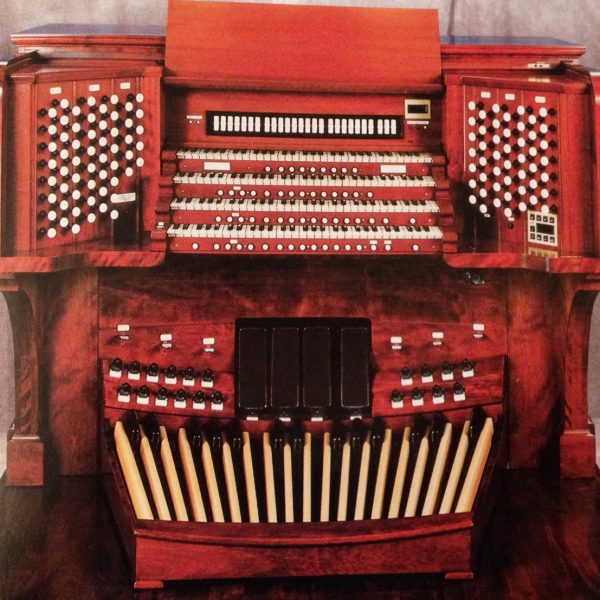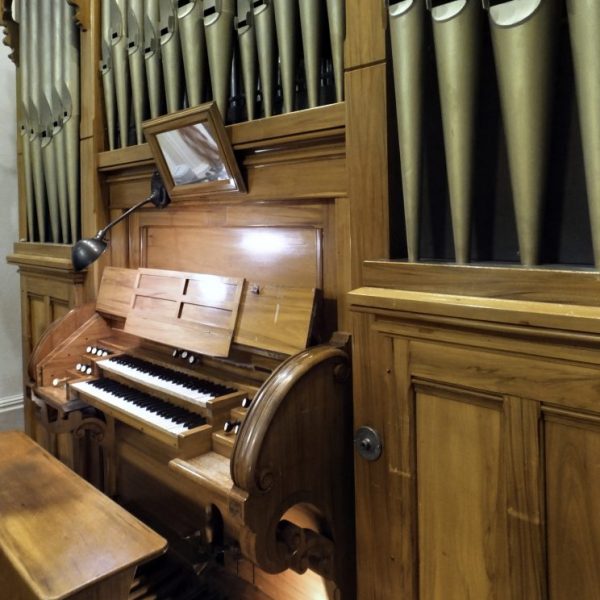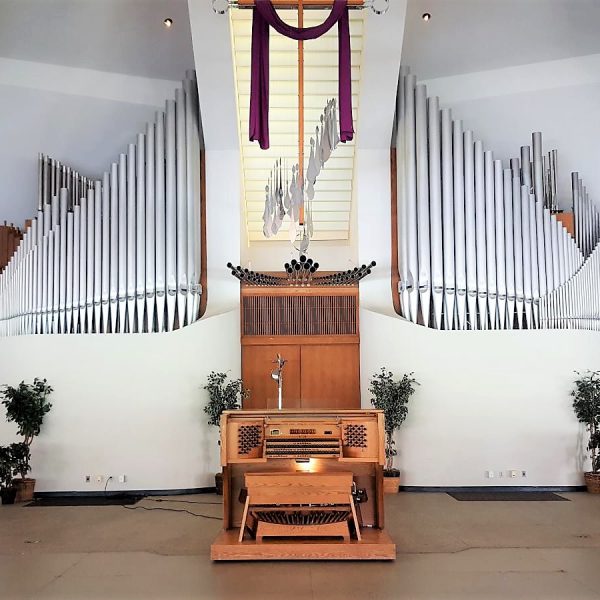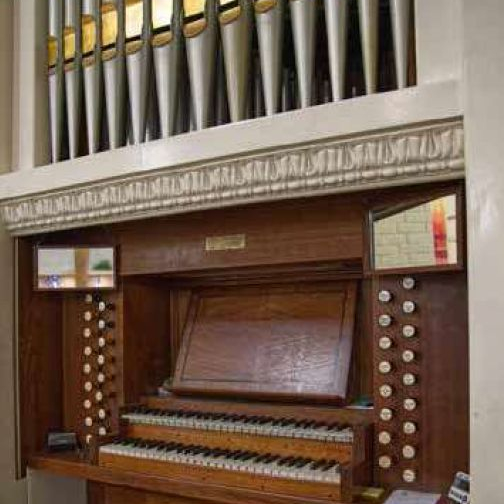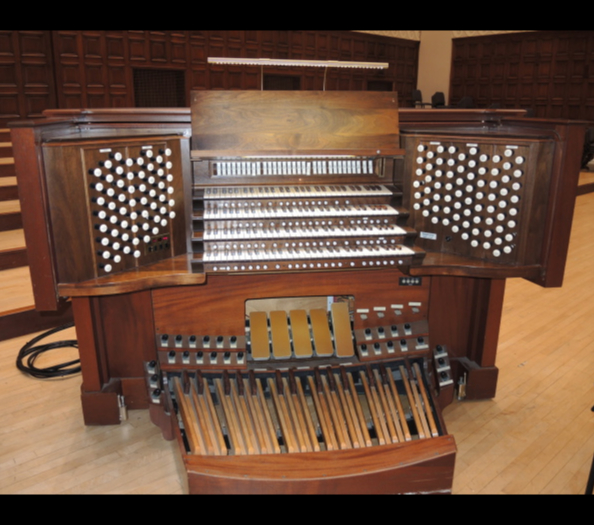University of Minnesota, Northrop Auditorium | Minneapolis, MN
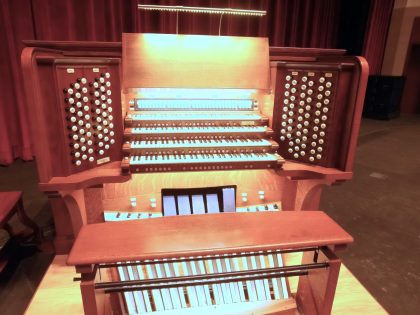
The historic Northrop pipe organ is a remarkable instrument worthy of recognition. An Aeolian-Skinner Opus 892, the organ was built between 1932 and 1936, and is one of the last remaining concert-hall pipe organs in the United States. With its nearly 7,000 pipes, the Northrop organ is approximately 40 feet tall and occupies an area the size of the Northrop stage. The largest of the organ's pipes is 32 feet tall, while the smallest is the size of a pencil. The public face of the organ is the console, the playable part of the instrument that rises on a platform from the orchestra pit with four keyboards and about 225 stops, pedals and buttons.
The Northrop organ is the third-largest auditorium-based Aeolian-Skinner extant in the U.S., and is one of the finest examples of a late-Romantic-era instrument. It was awarded the prestigious “Exceptional Historic Merit” citation by the Organ Historical Society in 1999, and organ scholars attest to the Aeolian Skinner’s historic value as a completely unaltered and intact example of the organ builder’s skill.
Along with its remarkable sound quality in concerts and performances, the Northrop Organ has been used as a teaching instrument throughout the years. Dr. Dean Billmeyer, who is the University Organist Emeritus, believes the organ is the single strongest factor in the U’s continuation of the organ instruction program and its ability to attract new students to the program.
Over the decades the Northrop organ fell into disrepair. By the early 1970s, it had nearly stopped working. Gordon Schultz, then a student at the University of Minnesota, started an effort to restore the unplayable organ and would sneak into Northrop on nights and weekends to work on it. Schultz had apprenticed with a Minneapolis organ shop and had an accommodating friend with a key who left certain Northrop doors open for him. More than three decades later, Schultz runs Gould and Schultz musical instrument company and travels the Midwest repairing and building pipe organs. He’s helped to maintain the organ ever since.
When the Northrop building renovation began in 2011, the organ was carefully moved to storage, where it sat for several years waiting for the funding needed to repair and reinstall the instrument. A generous bequest by the late Dr. Roger E. Anderson, long-time supporter of the Friends of the Northrop Organ, provided funds for the reinstallation of the instrument in its new location in the chambers above the stage and behind the proscenium.
The reinstallation, which has been painstakingly carried out by Foley-Baker and Associates, culminated in a grand inaugural concert on Oct 12-13, 2018, featuring the Minnesota Orchestra, conductor Osmo Vänskä and renowned organist Paul Jacobs.
In addition to the Saint-Saens Organ Symphony No. 3 (a nod to the first concert played on the Northrop organ) the program featured the world premiere of a commissioned contemporary work for organ by composer John Harbison, one of America’s most distinguished artistic figures. Northrop, the Minnesota Orchestra and the Seattle Symphony were commissioning partners for this new symphonic work. (text courtesy of the University of Minnesota)
The Friends of the Northrop Organ committee continues to meet on a regular basis to promote the historic instrument, support student and faculty recitals, and plan programming for future seasons to spotlight the restored pipe organ.
We began negotiations to sample the instrument in 2018, and finally signed a contract in 2022, with sampling commencing in late September of that year. We sampled from 2 locations - about 50 feet away from the stage on the floor of the first crossing aisle, and at the front of the first balcony, 100 feet away. So, 4 channels total, raw files at 24 bit/96kHz. Interestingly enough, the balcony perspective sounds more direct, since it is in almost direct line to the chambers. For that reason, even though it is further away, we chose to label that perspective as "direct", since that is how it sounds. Custom Organ Works was commissioned to build a console using the same dimensions and duplicating the console controls (pistons, etc.) for use as a practice instrument when the auditorium is unavailable. This will allow students to set registrations and hear balances away from the venue, and then spend the majority of practice time on performance when in the auditorium. The console will also be used in the Ted Mann concert hall when organ is needed.
We are thrilled to be trusted with the digital recreation of this iconic organ, and trust it will be a useful tool for the University musicians and an exciting addition the Hauptwerk community.
Encryption
The samples are offered in 48kHz/24bit resolution, and feature up to 3 loops per sample, tremulants are sampled. The multiple releases have three levels: short, mid and long. The sample set is encrypted via the iLok system used in Hauptwerk. There are controls to detune the flues, reeds and upperwork on the control page.
The sample set is offered in the Surround variant (4 channels). As mentioned on the "about" tab, the further perspective sounds much more direct, so is labeled as such. The reverb is around 2 seconds at most, the sample set responds very well to added reverb via the HW convolution feature. Below is a screenshot of one of our favorite reverb settings in HW:
Reverb time
The reverb time is ca. 1.5~2 seconds.
Keyboards, pedalboard
The original compass of the keyboards is 61 keys, with many ranks extended to 73 notes, the sample set faithfully reproduces this behavior. The original compass of the pedal division is 32 notes.
Requirements
RAM consumption
- 16-bit, other settings default: 16 GB
- 24-bit, other settings default: 32.1 GB
Interface Screenshots
Stoplist
GREAT ORGAN SWELL ORGAN
16' Diapason 61 16' Bourdon 73
8' First Diapason 61 16' Gemshorn 73 c
8' Second Diapason 61 8' Geigen Diapaon 73
8' Third Diapason 61 a 8' Hohlflöte 73
8' Flute Harmonique 61 8' Rohrflöte 73
8' Gedeckt * 61 b 8' Flauto Dolce 73
8' Viola pf 8' Flute Celeste (TC) 61
8' Gemshorn 61 8' Salicional 73
5 1/3' Quint 61 a 8' Voix Celeste 73
4' Octave 61 8' Echo Gamba 73
4' Second Octave 61 a 8' Echo Celeste 73
4' Flute * 61 4' Octave Geigen 73
3 1/5' Tenth 61 a 4' Flute 73
2 2/3' Twelfth 61 4' Violina 73 c
2' Fifteenth 61 2 2/3' Twelfth 61 c
IV Harmonics 244 2' Fifteenth 61 c
VII Plein Jeu * 427 a V Dolce Cornet 305 c
16' Contra Tromba * 61 a V Chorus Mixture 305
8' Tromba * 61 16' Posaune 73
4' Octave Tromba * 61 a 8' French Trumpet 73 a
Chimes SO 8' Cornopean 73
8' Harp CH 8' Oboe 73
4' Celesta CH 8' Vox Humana 73
* enclosed 4' Clarion 73
Tremolo
CHOIR ORGAN Chimes SO
16' Contra Viola 73 8' Harp CH
8' Diapason 73 4' Celesta CH
8' Concert Flute 73
8' Cor de Nuit 73 c PEDAL ORGAN
8' Dulcet II 134 c 32' Double Open Diapason 12 c
8' Dulciana 73 32' Sub Bourdon 5
8' Unda Maris (TC) 61 16' Diapason 32
4' Flute 73 16' Metal Diapason 32 a
4' Gemshorn 73 c 16' Contre Basse 32
2 2/3' Nazard 61 16' Bourdon 32
2' Piccolo 61 16' Diapason GT
1 3/5' Tierce 61 16' Contra Gamba SO a
1 1/3' Larigot 61 16' Contra Viola CH
III Dulciana Mixture 183 16' Gemshorn SW c
16' Fagotto 73 c 16' Echo Lieblich SW
8' Trumpet 73 c 8' Octave 12
8' Orchestral Oboe 73 c 8' Cello 32
8' Clarinet 73 8' Gedeckt 12
Tremolo 8' Viole CH
8' Harp (tc) -- 8' Still Gedeckt SW
4' Celesta 5 1/3' Twelfth 7 c
4' Super Octave 24 c
SOLO ORGAN 4' Flute 5
16' Contra Gamba 73 b V Harmonics 160 c
8' Flauto Mirabilis 73 b 32' Bombarde 12 c
8' Gamba 73 b 32' Contra Fagotto 12 CH c
8' Gamba Celeste 73 b 16' Trombone 32
8' Aetherial Celeste II 146 b 16' Posaune SW
4' Orchestral Flute 73 b 16' Fagotto CH c
4' Octave Gamba 73 b 8' Tromba 12
III Cornet de Violes 183 b 4' Clarion 12
16' Corno di Bassetto 73 c Chimes SO
8' Tuba Mirabilis 73
8' English Horn 73 c
8' French Horn 73
4' Tuba Clarion 73 c
Tremolo
Chimes a added as Op. 892-A in 1933
8' Harp CH b added as Op. 892-B in 1934
4' Celesta CH c added as Op. 892-C in 1936
Great Stops Audio Demo:
Comparison Demo:
(one of these recordings is Hauptwerk, one is a live recording in the room on the actual organ. Mics are in the same place, MIDI file is identical, registration is the same)
Demos on Contrebombarde - see below or use THIS LINK
Messiaen performed by Charlie Raasch:
NOTE - all updates are cumulative, so simply apply the latest available update to receive all fixes
12-17-2023 - 1.02 fixes a couple mis-assigned couplers and Unda Maris sounding in the wrong octave
12/23/2023 - 1.04 fixes some bad behavior in the French Trumpet with Tremulant engaged, manual divisions unwanted coupling thru to pedal (example: when SW is coupled to Ch and then ch coupled to PD, SW is also coupled to PD), 2 bad notes - one in the Cor de Nuit and one in the GT Fifteenth
1/25/2024 - 1.2, ODF 1.4 Complete revision (noise reduction redone from raw files) of several stops (Solo strings, Flauto Mirabilis, SW strings, GT Flute Harmonique and 2nd and 3rd Diapasons - ambient perspective). A number of other small fixes - releases or bad notes. Note: If you purchased on or after 27 January 2024, you have the most recent updates already applied, there is no need to apply this update.
![]()
Purchase a perpetual license for $549 - You will be redirected to our fulfillment service, FastSpring
![]()
Purchase a fully-functional 2-week demo license for $3.00 - You will be redirected to our fulfillment service, FastSpring
NOTE - Only one demo license per customer per sample set - attempts to redeem a second demo code will fail.
